fuel BUICK CENTURY 1994 Owners Manual
[x] Cancel search | Manufacturer: BUICK, Model Year: 1994, Model line: CENTURY, Model: BUICK CENTURY 1994Pages: 308, PDF Size: 16.3 MB
Page 14 of 308
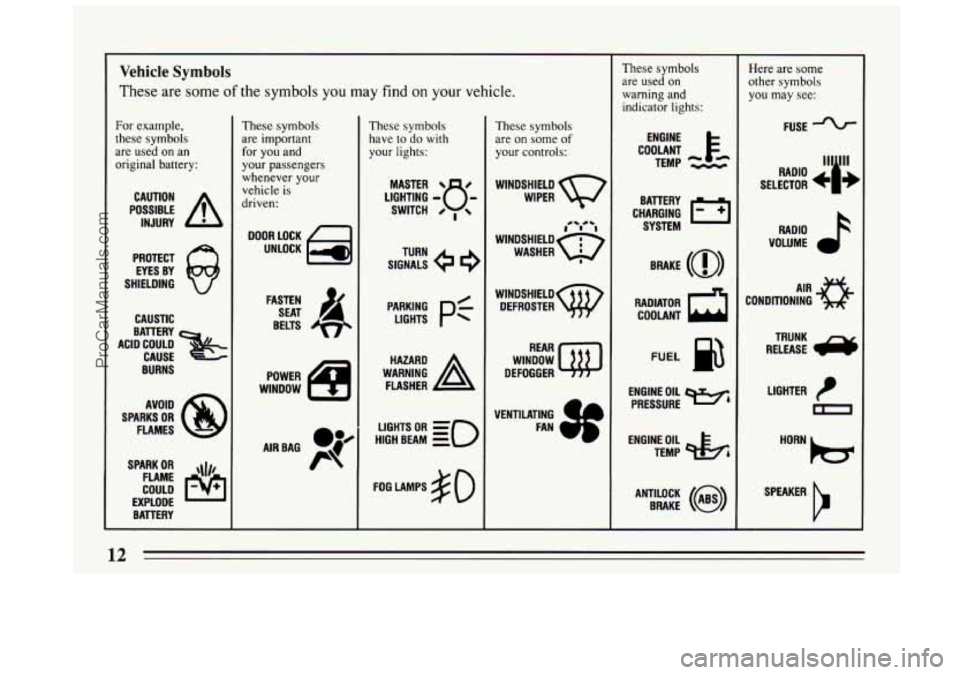
Vehicle Symbols
These are some of the symbols you may find on your vehicle.
Fur example,
these symbols
are used on an
original battery:
POSSIBLE A
CAUTION
INJURY
PROTECT EYES BY
SHIELDING
Q
CAUSTIC
BURNS AVOID
SPARKS
OR
FLAMES
SPARK
OR ,\I/,
COULD FLAME
EXPLODE BATTERY
These symbols
are important
for you and
your passengers whenever your
vehicle is
driven:
FASTEN SEAT 4
BELTS
POWER
WINDOW
AIRBAG P
These symbols have
to do with
your lights:
SIGNALS e
TURN
HIGH BEAM
OR = =o
FOG LAMPS $0
These symbols
are
on some of
your controls:
WIPER v
WINDSHIELDw DEFROSTER
WINDOW
DEFOGGER
VENTILATING FAN
These symbols
are used
on
warning and
indicator lights:
COOLANT F&
TEMP -.--
ENGINE
CHARGING
I-1
BAllERY SYSTEM
RADIATOR COOLANT
a
FUEL
ENGINE OIL e,
PRESSURE
TEMP
OIL 4%
ANTILOCK (@)
BRAKE
Here are some
other symbols
you may see:
FUSE
RADIO
k
VOLUME J
CONDITIONING A'R 0
RELEASE 6
TRUNK
LIGHTER
m
ProCarManuals.com
Page 79 of 308
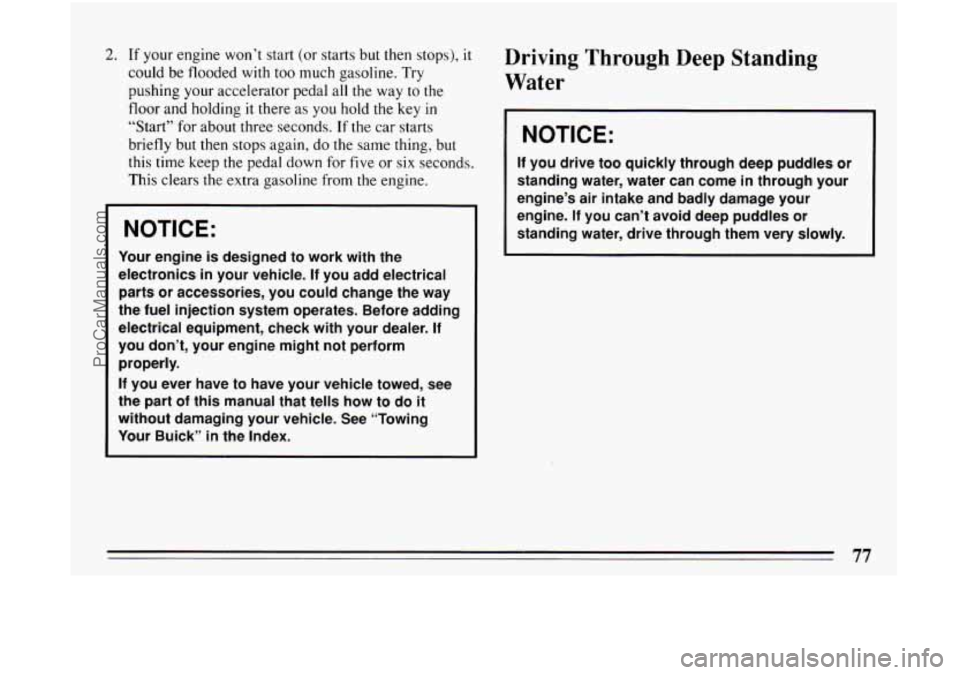
2. If your engine won’t start (or starts but then stops), it
could be flooded with too much gasoline. Try
pushing your accelerator pedal
all the way to the
floor and holding it there as you hold the key in
“Start” for about three seconds. If the car starts
briefly but then stops again, do the same thing, but
this time keep
the pedal down for five or six seconds.
This clears the extra gasoline from the engine.
I NOTICE:
Your engine is designed to work with the
electronics
in your vehicle. If you add electrical
parts or accessories, you could change the way
the fuel injection system operates. Before adding
electrical equipment, check with your dealer.
If
you don’t, your engine might not perform
properly.
If you ever have to have your vehicle towed, see
the part
of this manual that tells how to do it
without damaging your vehicle. See “Towing
Your Buick”
in the Index.
Driving Through Deep Standing
Water
I NOTICE:
If you drive too quickly through deep puddles or
standing water, water can come
in through your
engine’s air intake and badly damage your
engine.
If you can’t avoid deep puddles or
standing water, drive through them very slowly.
77
ProCarManuals.com
Page 80 of 308

Engine Coolant Heater (Engine Block Heater) (Canada Only)
In very cold weather, 0°F (-18°C) or colder, the engine
coolant heater can help. You’ll get easier starting and
better fuel economy during engine warm-up. Usually,
the coolant heater should be plugged
in a minimum of
four hours prior to starting your vehicle.
To use the coolant heater:
1. Turn off the engine.
2. Open the hood and unwrap the electrical cord.
3. Plug it into a normal, grounded 110-volt outlet.
I NOTICE:
After you’ve used the coolant heater, be sure to
store the cord
as it was before to keep it away
from moving engine parts. If you don’t, it could
be damaged.
How long should you keep the coolant heater plugged
in? The answer depends on the weather, the kind
of oil
you have, and some other things. Instead of trying to list
everything here, we ask that you contact a Buick dealer
in the area where you’ll be parking your vehicle. The
dealer can give you the best advice for that particular
area.
78
ProCarManuals.com
Page 83 of 308
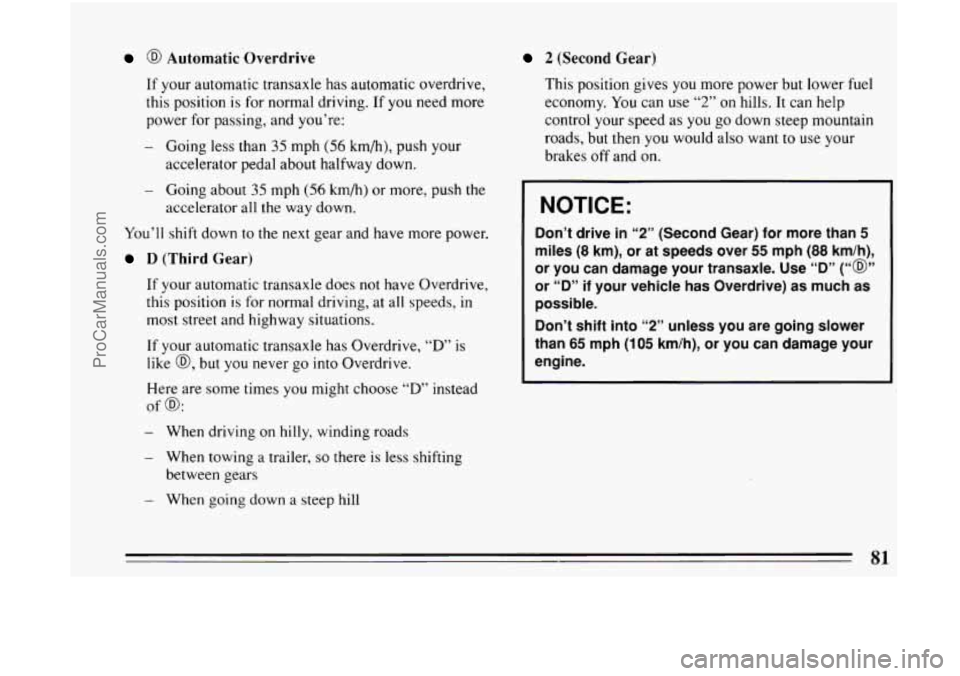
@ Automatic Overdrive
If your automatic transaxle has automatic overdrive,
this position is for normal driving.
If you need more
power for passing, and you’re:
- Going less than 35 mph (56 km/h), push your
accelerator pedal about halfway down.
accelerator all
the way down.
- Going about 35 mph (56 km/h) or more, push the
You’ll shift down to the next gear and have more power.
D (Third Gear)
If your automatic transaxle does not have Overdrive,
this position is for normal driving, at all speeds,
in
most street and highway situations.
If your automatic transaxle has Overdrive,
“D” is
like
@, but you never go into Overdrive.
Here are some times
you might choose “D” instead
of
03:
- When driving on hilly, winding roads
- When towing a trailer, so there is less shifting
- When going down a steep hill
between gears
2 (Second
Gear)
This position gives you more power but lower fuel
economy.
You can use “2” on hills. It can help
control your speed as you go down steep mountain
roads, but then
you would also want to use your
brakes off and
on.
I NOTICE:
Don’t drive in “2” (Second Gear) for more than 5
miles (8 km), or at speeds over 55 mph (88 km/h),
or you can damage your transaxle. Use “D”
(‘@’’
or “D” if your vehicle has Overdrive) as much as
possible.
Don’t shift into
“2” unless you are going slower
than
65 mph (1 05 km/h), or you can damage your
engine.
81
ProCarManuals.com
Page 84 of 308
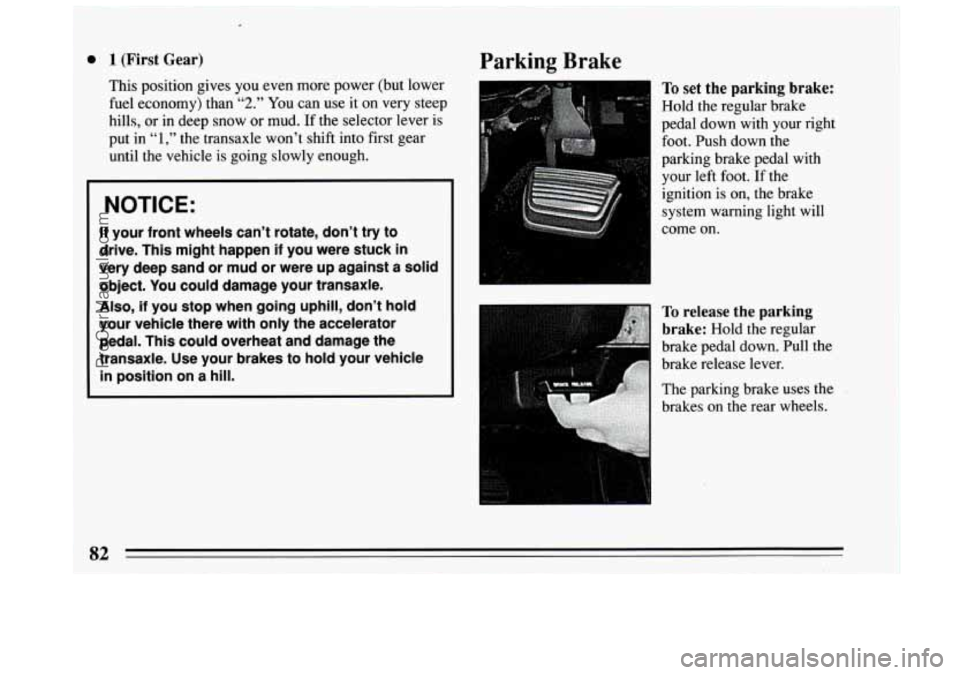
c
0 1 (First Gear)
This position gives you even more power (but lower
fuel economy) than
“2.” You can use it on very steep
hills, or in deep snow or mud. If the selector lever is
put in
“1,” the transaxle won’t shift into first gear
until the vehicle
is going slowly enough.
NOTICE:
If your front wheels can’t rotate, don’t try to
drive. This might happen if you were stuck
in
very deep sand or mud or were up against a solid
object. You could damage your transaxle.
Also, if you stop when going uphill, don’t hold
your vehicle there with only the accelerator
pedal. This could overheat and damage the
transaxle. Use your brakes to hold your vehicle
in position on a hill.
Parking Brake
To set the parking brake:
Hold the regular brake
pedal down with your right
foot. Push down the
parking brake pedal with
your left foot.
If the
ignition is on, the brake
system warning light will
come on.
To release the parking
brake:
Hold the regular
brake pedal down. Pull the
brake release lever.
ProCarManuals.com
Page 112 of 308
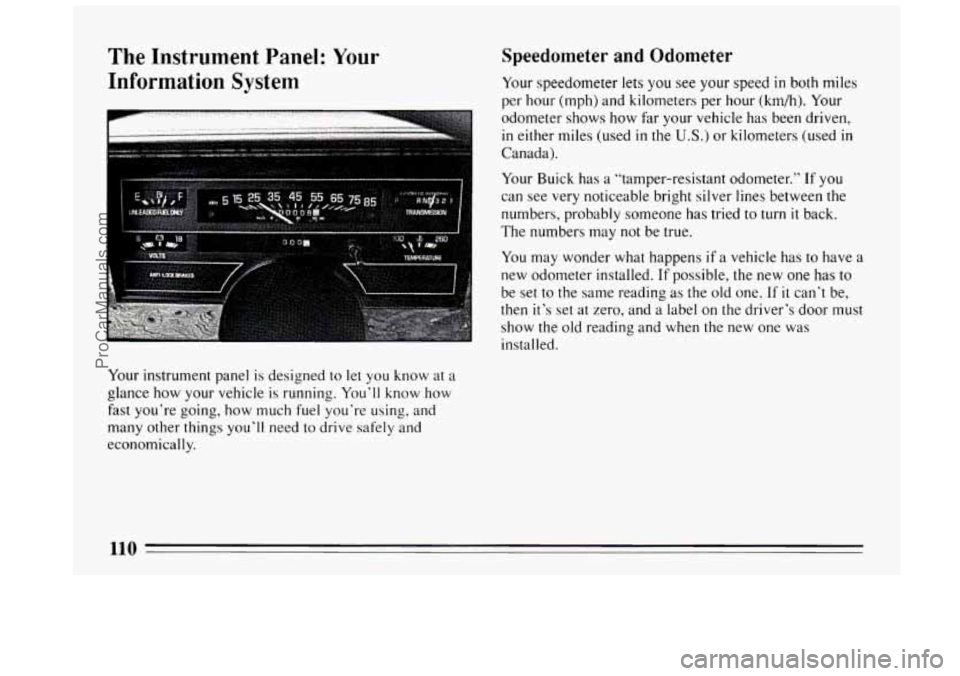
The Instrument Panel: Your
Information System
Your instrument panel is designed to let you know at a
glance how your vehicle is running. You’ll know how
fast you’re going, how much
fuel you’re using, and
many other things you’ll need to drive safely and
economically.
Speedometer and Odometer
Your speedometer lets you see your speed in both miles
per hour (mph) and kilometers per hour (km/h). Your
odometer shows how far your vehicle has been driven,
in either miles (used in the U.S.) or kilometers (used in
Canada).
Your Buick has a “tamper-resistant odometer.”
If you
can see very noticeable bright silver lines between the
numbers, probably someone has tried to turn
it back.
The numbers may not be true.
You may wonder what happens if a vehicle has
to have a
new odometer installed.
If possible, the new one has to
be set to the same reading as the old one.
If it can’t be,
then it’s set at zero, and a label on the driver’s door must
show the old reading and when the new one was
installed.
110
ProCarManuals.com
Page 114 of 308
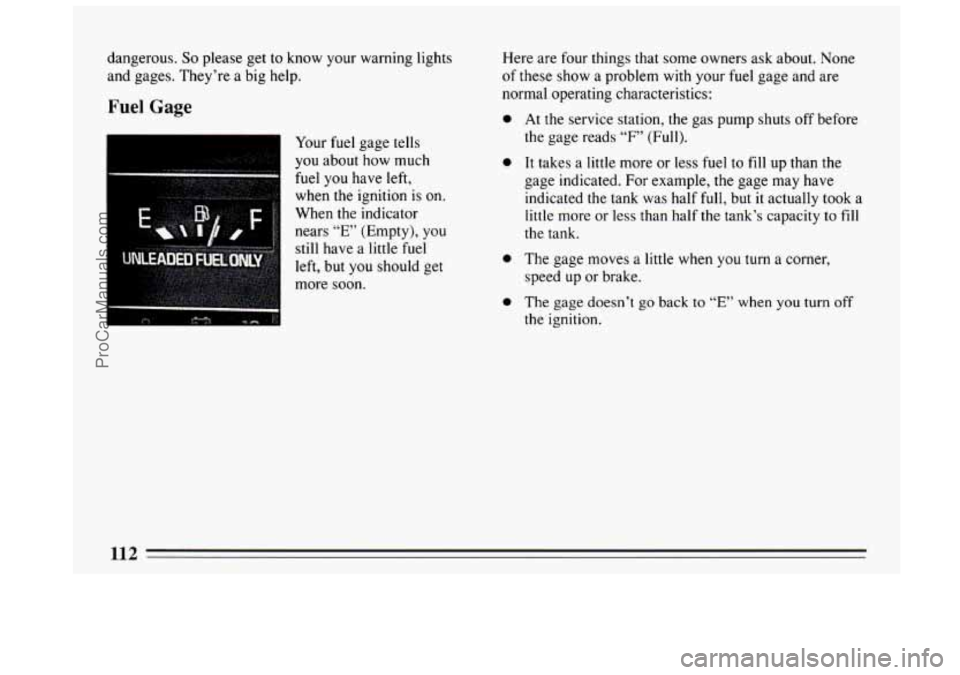
dangerous. So please get to know your warning lights
and gages. They’re a big help.
Fuel Gage
I
Your fuel gage tells
you about how much
fuel you have left,
when
the ignition is on.
When the indicator
nears
“E” (Empty), you
still have a little fuel
left, but you should get
more soon. Here
are four things that some owners ask about. None
of these show a problem with your fuel gage and are
normal operating characteristics:
0
0
0
0
At the service station, the gas pump shuts off before
the gage reads
“F” (Full).
It takes a
little more or less fuel to fill up than the
gage indicated. For example,
the gage may have
indicated the tank was half
full, but it actually took a
little more or less than half the tank’s capacity to
fill
the tank.
The gage moves a little when you
turn a corner,
speed up or brake.
The gage doesn’t go back to
“E” when you turn off
the ignition.
112
ProCarManuals.com
Page 118 of 308
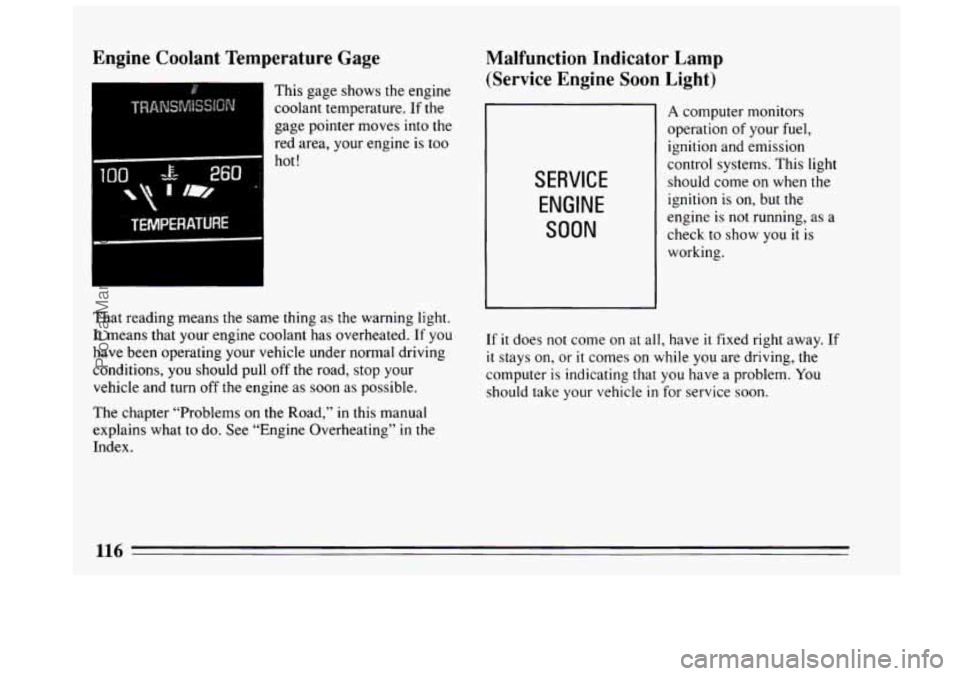
Engine Coolant Temperature Gage
This gage shows the engine
coolant temperature. If the
gage pointer moves into the
red area, your engine is too
100 -E- 260 i
T lm,
hot!
TEMPERATURE
That reading means the same thing as the warning light.
It means that your engine coolant has overheated. If you
have been operating your vehicle under normal driving
conditions, you should pull off the road, stop your
vehicle and
turn off the engine as soon as possible.
The chapter “Problems on the Road,”
in this manual
explains what
to do. See “Engine Overheating” in the
Index.
Malfunction Indicator Lamp
(Service Engine Soon Light)
SERVICE
ENGINE
SOON
A computer monitors
operation of your fuel,
ignition and emission
control systems. This light
should come on when the
ignition is on, but the
engine is not running, as
a
check to show you it is
working.
If it does not come on at all, have it fixed right away. If
it stays on, or it comes on while you are driving, the
computer is indicating that
you have a problem. You
should take your vehicle
in for service soon.
116
ProCarManuals.com
Page 119 of 308
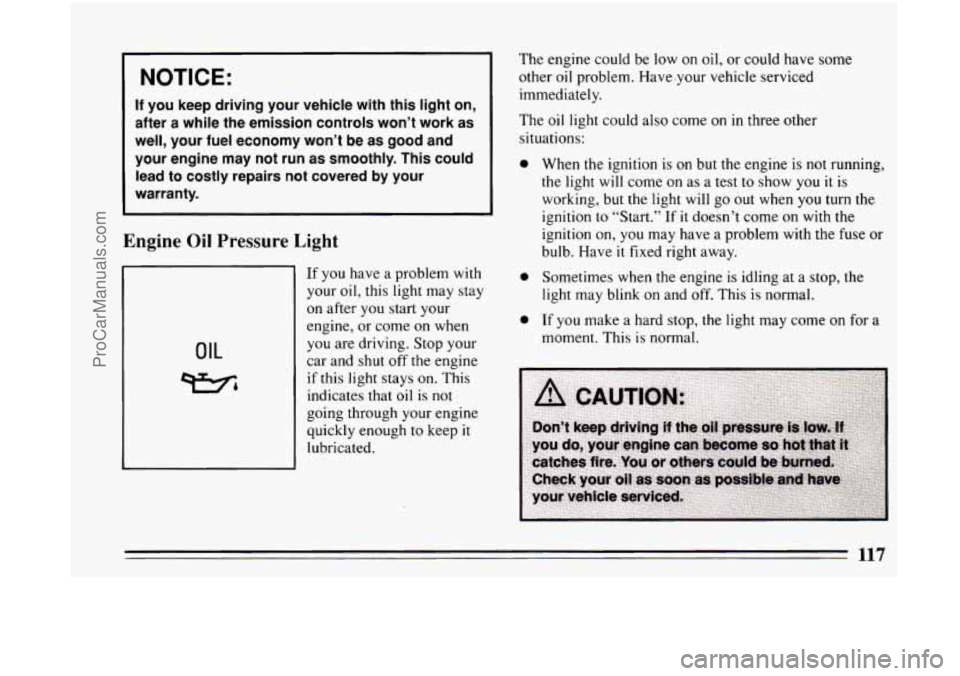
I NOTICE:
If you keep driving your vehicle with this light on,
after a while the emission controls won’t work as
well, your fuel economy won’t be as good and your engine may not run as smoothly. This could
lead to costly repairs not covered by your
warranty.
Engine Oil Pressure Light
OIL
If you have a problem with
your oil, this light may stay
on after you start your
engine, or come
on when
you are driving. Stop your
car and shut off
the engine
if this light stays on. This
indicates that oil is not
going through your engine
quickly enough to keep
it
lubricated. The engine
could be low
on oil, or could have some
other oil problem. Have.your vehicle serviced
immediately.
The oil light could also come on in three other
situations:
0
0
0
When the ignition is on but the engine is not running,
the light will come on as a
test to show you it is
working, but
the light will go out when you turn the
ignition to “Start.” If
it doesn’t come on with the
ignition on,
you may have a problem with the fuse or
bulb. Have
it fixed right away.
Sometimes when the engine is idling at a stop, the
light may blink on and
off. This is normal.
If you make a hard stop, the light may come on for
a
moment. This is normal.
117
ProCarManuals.com
Page 124 of 308
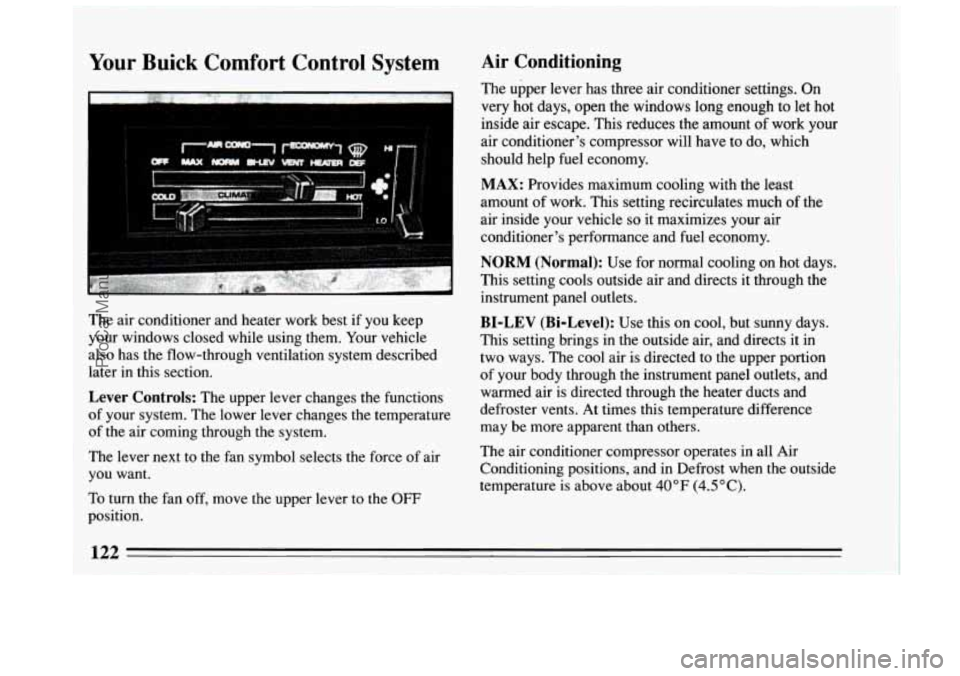
Your Buick Comfort Control System
The air conditioner and heater work best if you keep
your windows closed while using them. Your vehicle
also has the flow-through ventilation system described
later in this section.
Lever Controls: The upper lever changes the functions
of your system. The lower lever changes the temperature
of the air coming through the system.
The lever next to the fan symbol selects the force of air
you want.
To turn the fan off, move the upper lever to the OFF
Air Conditioning
The upper lever has three air conditioner settings. On
very hot days, open the windows long enough to let hot
inside air escape. This reduces the amount of work your
air conditioner's compressor will have to do, which
should help fuel economy.
MAX: Provides maximum cooling with the least
amount of work. This setting recirculates much
of the
air inside your vehicle
so it maximizes your air
conditioner's performance and fuel economy.
NORM (Normal): Use for normal cooling on hot days.
This setting cools outside air and directs it through the
instrument panel outlets.
BI-LEV (Bi-Level): Use this on cool, but sunny days.
This setting brings in the outside air, and directs it in
two ways. The cool air is directed to the upper portion
of your body through the instrument panel outlets, and
warmed air is directed through the heater ducts and
defroster vents. At times this temperature difference
may be more apparent than others.
The air conditioner compressor operates in all Air
Conditioning positions, and in Defrost when the outside
temperature is above about 40°F (4.5"C).
position.
__
ProCarManuals.com